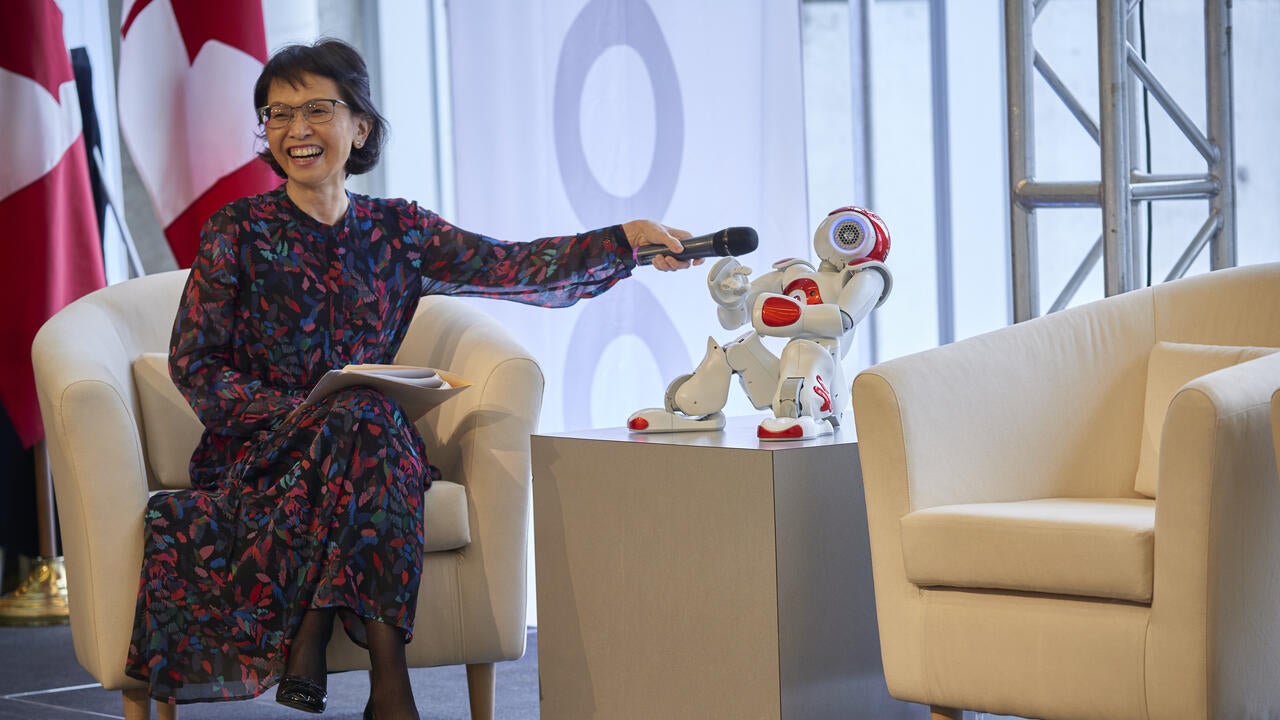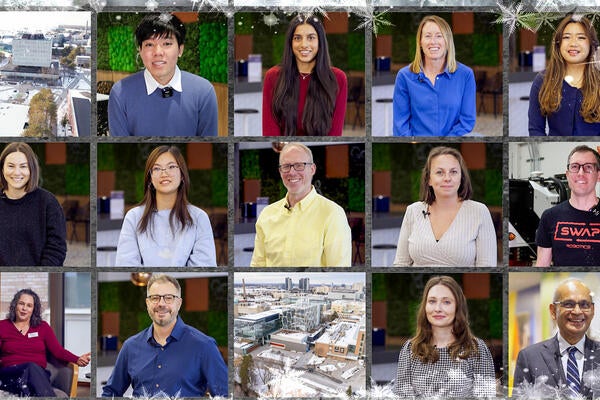
Pearl Sullivan to step down as dean
After leading Waterloo engineering for over seven years, she will now focus on major Faculty and University initiatives

After leading Waterloo engineering for over seven years, she will now focus on major Faculty and University initiatives
By Carol Truemner Faculty of EngineeringPearl Sullivan, Waterloo Engineering’s eighth dean of engineering, will leave the post at the end of this year.
The first woman to hold the position and just the fourth across Canada to head an engineering faculty, she continues to be a dynamic force for Waterloo Engineering and for the entire University.
Under her leadership beginning July 2012, the Faculty has reimagined engineering education and research with revolutionary spaces and transformative programs that will ensure Waterloo remains a leader in engineering well into the future.
Richard (Rick) Culham, a Waterloo mechanical and mechatronics engineering professor and an alumnus, will serve as interim dean beginning January 1, 2020.
Sullivan will continue on as a Waterloo Engineering mechanical and mechatronics professor, a position she’s held since she joined the University in 2004. She will also lead high-profile projects for both the University and the Faculty.
As she prepares for the next stage of her career, Sullivan reflects on her seven and a half years at the helm of Waterloo Engineering.
Q: What does it mean to you to have been the first woman to serve as dean of Waterloo Engineering and just the fourth across Canada to head an engineering faculty?
A. I actually didn’t give it much thought when I was appointed and still don’t think too much about it.
It was a humbling experience to learn that I had been nominated as Dean in 2012 and over the years I have cherished the honour and privilege of serving in the role. I have appreciated the wonderful support and encouragement of the university president and four provosts.
Perhaps this may be a bit due to self-consciousness, but I sometimes think there are higher expectations for women and possibly greater scrutiny especially when it involves controversial matters.
Q. What have you enjoyed most in your role as dean?
A. It is a most interesting job in which I am constantly impressed by the creativity and superb ideas from our faculty, staff and students. I’ve also enjoyed the opportunity I’ve had to meet some of the most influential thought leaders in the technology sector.
The role has allowed me to understand the issues and achievements of multiple portfolios, including teaching and research, undergraduate and graduate studies, international and outreach engagements, and the workings of the entire University.
I particularly enjoy developing strategy and advancement/fundraising projects and executing major strategic initiatives.
But I must say, spontaneous meetups with our students especially in their design and classroom activities, along the hallways, and in the elevators are the most fun!

Engineering students share a laugh with their dean, pictured at centre.
Q. What three initiatives are you most proud to have led as dean?
A. First, over the years I have sensed the overwhelming pride our students, staff and faculty members have for Waterloo Engineering. They are clearly proud of the Faculty’s strong reputation, our exceptional undergraduate programs and the depth and breadth of our network, both among our alumni and across industry.
While Waterloo Engineering is the largest engineering school in Canada, we are in many ways decentralized. The Faculty’s leadership meets every Tuesday and the collegial planning and decision-making have led to a remarkably harmonious Faculty.
Second is the building of Engineering 7, literally without a dollar on hand at the beginning of the project.
It took a strong team effort, which included the Dean’s Office, four departments, student leaders, the Engineering Ideas Clinic® team, Engineering Machine Shop staff and researchers from across the Faculty. The Engineering Advancement team did an amazing job with our “Educating the Engineer of the Future” fundraising campaign.
Engineering 7 has proven to be much more than just a building. It has brought together the entire Faculty by physically connecting all of our engineering buildings and has become the showcase for leading-edge research, teaching innovation, and entrepreneurship to the outside world.
As the main link to the other engineering buildings, Engineering 7 provides a strong family atmosphere for faculty and staff and resonates the pulse of the student body experience. All facilities are well used by faculty for their conferences and events and the building’s social spaces are enjoyed by the students.
Finally, it took me a couple of years to realize that my core responsibility as dean was to develop strategy and support faculty colleagues who pursue resources for strategic projects.

Pearl Sullivan, second from left, participates in the ground-breaking ceremony for Engineering 7 with then engineering student and president of EngSoc Hannah Gautreau, far left, University of Waterloo President Feridun Hamdullahpur, second from right, and then PhD candidate in mechanical and mechatronics engineering Elahe Jabari, far right.
At the outset, our core strategy was to build infrastructure and recognition through national and provincial research awards. This recognition and funding have resulted in the launch of the Waterloo Artificial Intelligence Institute and establishment of chairs such as the C150 Chair in Intelligent Robotics and the Canada Excellence Research Chair (CERC) in Human-Centered Robotics and Machine Intelligence.
We’ve also been awarded multiple prestigious Canada Foundation of Innovation projects, including two for the Multiscale Additive Manufacturing Lab, the Advanced Manufacturing Consortium (AMC), the Robotics Hub and the Autonomous Vehicle Research and Intelligence Lab (AVRIL).
None of this would have been possible without the tireless work and ingenuity of my very talented faculty and staff colleagues. It is fair to say that Waterloo Engineering has now distinguished itself nationally and globally as the hub for robotics, machine intelligence and autonomous systems.
And we have found our niche in unique areas of advanced manufacturing that has attracted hundreds of companies to campus.
Certainly, the day-to-day operations need to be running effectively before a department or unit can sustain these initiatives. I believe the Faculty’s work over the past two years in the Engineering Budget Model will provide much-needed transparency to all areas and enable them to plan forward.
Q. Although you’re stepping down as dean, you will continue to focus on major projects for the University and the Faculty. What do you hope to accomplish in your new role?
A. I am currently leading two major initiatives – one national, the other international. The international initiative, in  particular, will be extremely challenging in terms of negotiating agreements, mitigating risk while managing relationships, and executing remotely.
particular, will be extremely challenging in terms of negotiating agreements, mitigating risk while managing relationships, and executing remotely.
My hope is to place both on solid footing so Waterloo is positioned as a global leader in these fields. At the same time, we are also developing a succession plan so that I can be replaced with new leadership once these initiatives are established.
Beginning January 1, I look forward to a slower pace, returning to my own research and, hopefully, getting more sleep!
Q. If you were a first-year engineering student today, what advice would you give yourself?
A. You worked very hard to get into Waterloo Engineering and you will work even harder to get out of Waterloo Engineering. But every bit of your sweat will be absolutely worthwhile!

Read more
Here are the people and events behind some of this year’s most compelling Waterloo stories

Read more
A winter holiday message from President Vivek Goel

Read more
The Waterloo community comes together to remember, reflect and respond to gender-based violence
The University of Waterloo acknowledges that much of our work takes place on the traditional territory of the Neutral, Anishinaabeg, and Haudenosaunee peoples. Our main campus is situated on the Haldimand Tract, the land granted to the Six Nations that includes six miles on each side of the Grand River. Our active work toward reconciliation takes place across our campuses through research, learning, teaching, and community building, and is co-ordinated within the Office of Indigenous Relations.